In today’s digital age, starting an online business is easier than ever before. With a range of e-commerce platforms available, it can be challenging for entrepreneurs to choose the best one for their business needs. Two of the most popular options are Shopify and Square online. While both platforms offer powerful eCommerce solutions, they have some fundamental differences that can make one more suitable than the other, depending on the type of business and the specific needs of the entrepreneur. In this article, we compare Shopify vs Square in various categories to help entrepreneurs make informed decisions and select the best platform for their online business. We analyze features such as ease of use, website design, payment options, inventory management, SEO, blogging, and pricing. By the end of this article, you will have a better understanding of the strengths and weaknesses of both platforms and be able to choose the one that fits your business requirements.
Table of Contents
Overview of Shopify and Square Online
Shopify
Shopify is a leading eCommerce platform that provides a variety of features to help merchants start, grow, and manage their online stores. This SaaS was founded in 2006 and has since grown to become one of the most popular eCommerce platforms in the world, powering over 1 million businesses in over 175 countries.
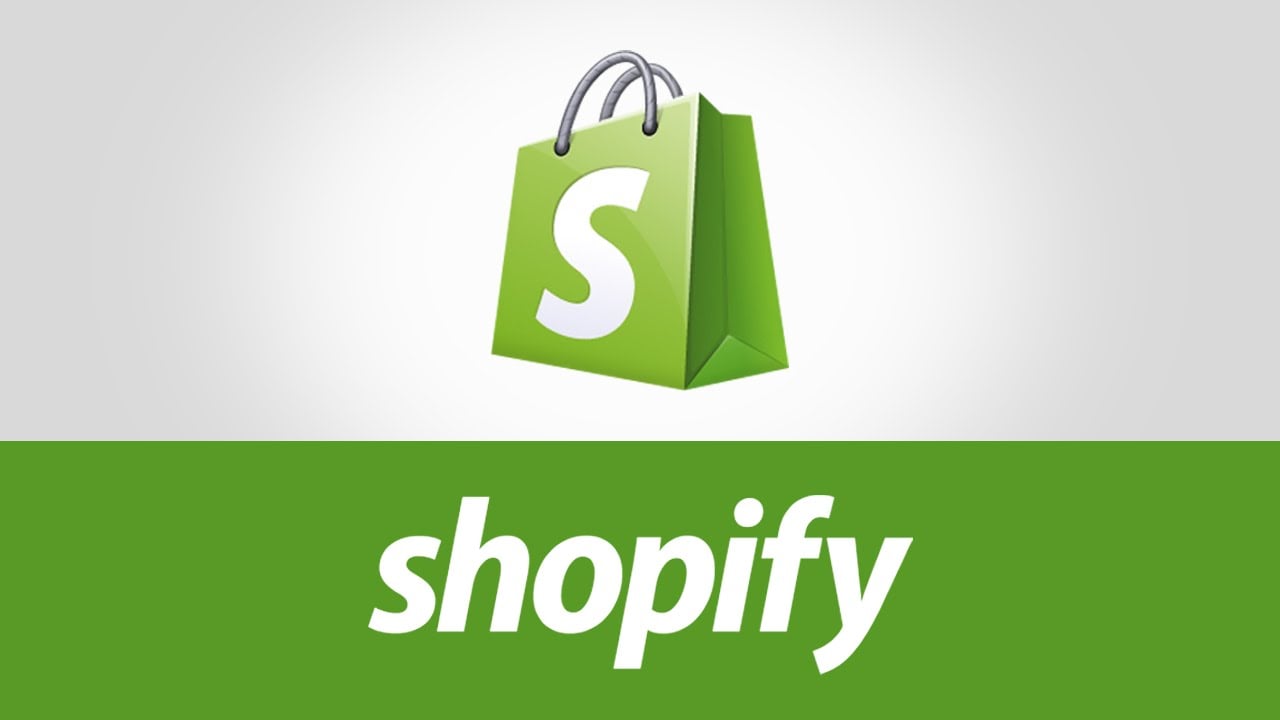
Shopify offers many tools and features for businesses to start and grow their online stores, including payment processing, inventory management, marketing and SEO tools, and customizable store design. This robust platform also provides a range of integrations and apps to help merchants add additional features and functionality to their stores.
Square
Square is a leading payments and financial services company that offers a wide range of tools and features to help merchants of all sizes manage their businesses. The company was founded in 2009 and has since grown to become a widely recognized brand in the payments industry, serving millions of businesses around the world.

Square online also offers a range of other tools and features to help merchants manage their businesses, including inventory management, appointment scheduling, customer relationship management, and point-of-sale solutions. Square’s tools are designed to be easy to use, with intuitive interfaces and a range of customization options to fit the needs of different businesses.
Shopify vs Square Online: Comparison
Ease of Use
Shopify vs Square Online is designed to be user-friendly and easy to use, with intuitive interfaces that require little technical expertise. However, there are some differences between Square store vs Shopify when it comes to ease of use.
Shopify is known for its user-friendly interface and drag-and-drop store builder, which makes it easy for merchants to create and customize their online stores without requiring technical expertise. The platform provides a comprehensive suite of tools and features, including inventory management, marketing and SEO tools, and customizable store design, which are all designed to be easy to use for merchants of all levels.
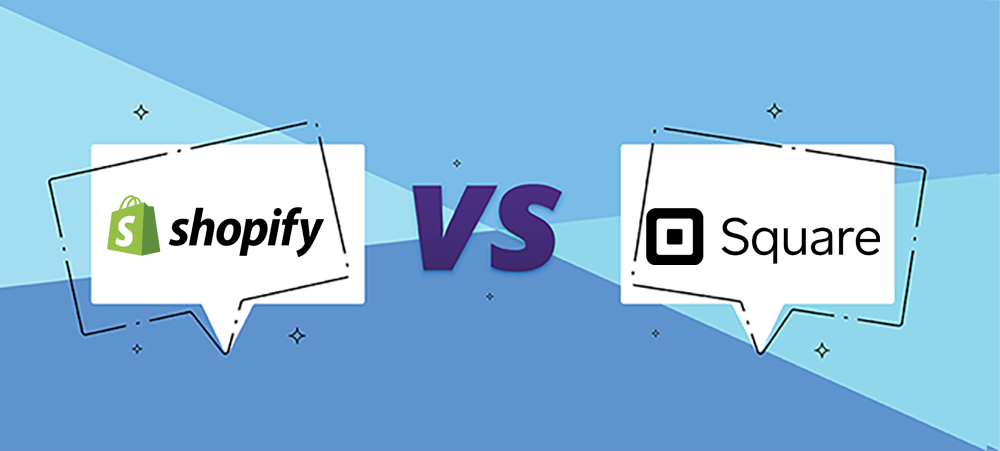
Square, on the other hand, offers a wider range of financial services and tools in addition to payment processing, which can make the platform more complex to navigate for merchants who are primarily focused on payment processing. However, Square’s interface is still designed to be user-friendly and intuitive, with a range of customization options to fit the needs of different businesses.
When comparing Shopify vs Square online in terms of ease of use, Shopify’s interface is more streamlined and easier to navigate for merchants who are primarily focused on selling products online. Square’s wider range of financial services and tools can make its interface more complex to navigate, but the platform still provides a user-friendly experience for merchants of all levels.
Website Design
Both Shopify and Square online provide a range of website design options to help merchants create attractive and functional online stores.

Here’s a comparison of Square vs Shopify online store in terms of website design:
- Store Builder: Shopify offers a drag-and-drop store builder that allows merchants to create and customize their online stores with ease. The platform provides a wide range of templates and themes that can be customized to fit the needs of different businesses, as well as a range of design and layout options that can be adjusted to create a unique look and feel. Square, on the other hand, does not offer a built-in store builder, but it does provide integrations with third-party website builders like Wix and Weebly.
- Customization: Both Shopify and Square online offer a range of customization options to help merchants create a unique and attractive online store. Shopify provides a wide range of design and layout options, as well as a theme editor that allows for advanced customization of the store’s look and feels. Square provides integrations with third-party website builders that offer a range of design and customization options.
- Responsive Design: Both Shopify and Square provide responsive website design, which means that their websites are optimized for viewing on mobile devices. This is important, as more and more customers are accessing online stores on their mobile devices.
- Design Quality: The quality of website designs on Shopify and Square can vary based on the templates and themes used, as well as the level of customization that merchants apply. However, Shopify is known for offering a wider range of high-quality templates and themes, which can help merchants create a more professional-looking online store. The number of templates available on Square is less than on Shopify. However, the small amount of work needed to set up a working site makes up somewhat for how straightforward the options are.
Payment Options
Both Shopify and Square offer payment processing services that allow merchants to accept credit card payments online and in person. Shopify’s payment processing is provided by Shopify Payments, which allows merchants to accept payments without having to use a third-party payment processor. Square, on the other hand, provides payment processing services through its own payment gateway, which integrates with its point-of-sale hardware and software.
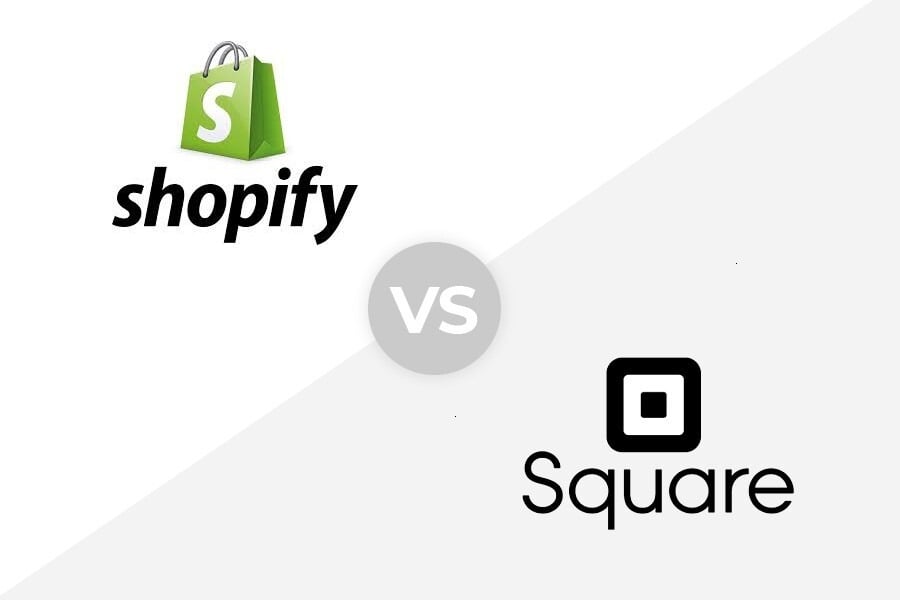
Regarding payment options, both platforms allow merchants to accept a range of payment options, including credit and debit cards, as well as alternative payment methods like PayPal, Apple Pay, and Google Pay. Shopify and Square Online also both support recurring billing for subscription-based businesses.
When comparing Square online store vs Shopify in terms of Point of Sale, Square offers a comprehensive point-of-sale system that allows merchants to accept payments in-person using hardware like a card reader or a mobile device. Shopify also offers point-of-sale hardware and software, but it is not as comprehensive as Square’s system.
In general, Shopify vs Square online provides a range of payment options and services to help merchants accept payments from their customers. However, Shopify is primarily focused on eCommerce and offers more robust payment processing services for online transactions, while Square online provides a comprehensive point-of-sale system that is ideal for brick-and-mortar businesses.
Inventory Management
Inventory management is a critical aspect of any eCommerce business, as it helps merchants keep track of their products and ensure that they have sufficient stock to meet customer demand.

Here’s a comparison of Shopify and Square in terms of inventory management:
- Inventory Tracking: Both Shopify and Square online offer inventory tracking features that allow merchants to manage their inventory levels, receive low-stock alerts, and track product history. Shopify’s inventory management system is built-in and allows for inventory management across multiple sales channels. Square online also provides inventory tracking capabilities through its Square for Retail software, which is designed for businesses with physical retail locations.
- Order Management: Both platforms provide tools to manage orders and ensure that inventory levels are updated automatically as sales are made. Shopify allows merchants to fulfill orders from multiple sales channels in a single location and provides integration with third-party shipping and fulfillment software. Square for Retail also provides order management tools, but it is primarily designed for in-person sales and may not be as well-suited to eCommerce businesses.
- Product Management: Both platforms allow merchants to add new products to their online store, and to manage product information like pricing, descriptions, and images. Shopify provides a range of product management tools, including the ability to manage product variants and SKUs and to create collections of related products. Square’s product management capabilities are more limited, and may not be as well-suited to businesses with a large number of SKUs or complex product lines.
Regarding comparing inventory management Squarespace store vs Shopify, Shopify’s built-in inventory management system is more robust and better suited to e-commerce businesses, while Square’s inventory management capabilities are more focused on in-person sales. Merchants should carefully consider their inventory management needs and choose the platform that is the best fit for their business.
Marketing and SEO Tools
Both platforms also offer a range of third-party apps to support marketing efforts. Shopify’s app store is one of the most extensive among eCommerce platforms, with over 4,000 apps available to download. These apps cover a broad range of features for marketing that can help businesses of all sizes and industries. Many of these apps are free, while others come with a monthly subscription fee.

Square’s app marketplace, on the other hand, is relatively smaller, with around 100 apps available to download. Square’s app marketplace also includes a range of free and paid apps, with subscription fees varying between each app. While Square’s app marketplace offers fewer options compared to Shopify’s, the apps available are generally high-quality and designed to integrate seamlessly with the Square platform.
SEO
When it comes to SEO (Search Engine Optimization), which is essential for raising your store’s ranks in search engine results pages, Shopify vs Square online store is comparable. Due to its SEO-specific app and better social media connectors, Shopify narrowly edges Square online out in the end.
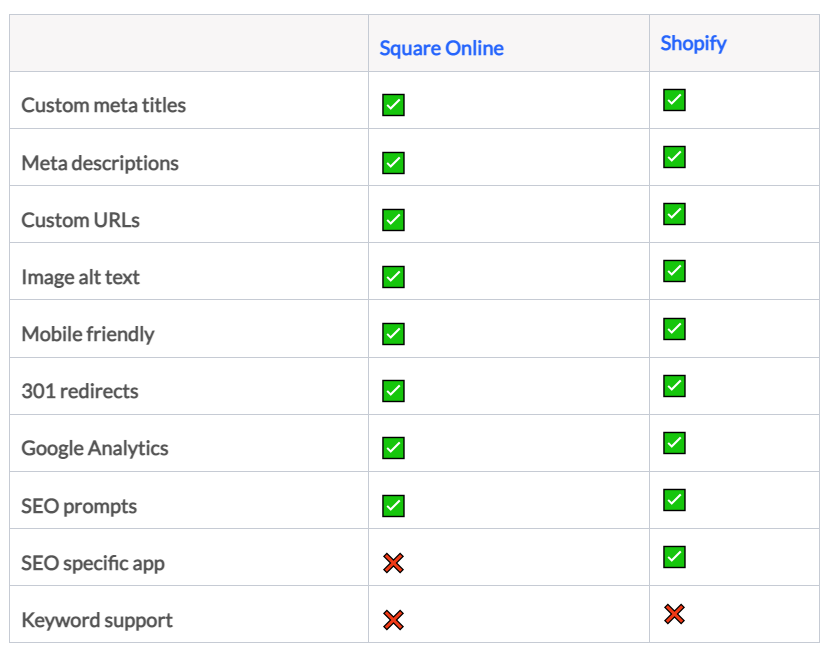
Blogging
Blogging is an important aspect of content marketing for eCommerce businesses, as it allows merchants to provide valuable information to their customers and establish themselves as thought leaders in their industry. Here’s a comparison of Shopify and Square in terms of blogging:
- Built-in Blogging Features: Both Shopify and Square provide built-in blogging features that allow merchants to create and publish blog posts on their online stores. Shopify’s blogging platform is well-designed and user-friendly and allows for advanced features like multiple authors, comment sections, and tagging. Square’s blogging platform is simpler and more limited, and may not be as well-suited to businesses with more advanced blogging needs.
- Third-party Blogging Tools: Shopify and Square online both integrate with third-party blogging tools that can help businesses with tasks like content creation, editing, and promotion. Shopify’s ecosystem of third-party blogging apps and plugins is larger and includes popular tools like Hootsuite, HubSpot, and Yoast SEO. Square’s integrations are more limited, and may not be as well-suited to businesses with more advanced blogging needs.

Both Shopify and Square provide built-in blogging features that can help businesses create and publish blog content. However, in the comparison of Shopify vs Square Online, Shopify’s blogging platform is generally more advanced and customizable, and its ecosystem of third-party blogging and SEO apps and plugins is larger. Additionally, Shopify’s theme library is more diverse and well-suited to businesses with more advanced design needs. Square online provides a solid foundation for blogging, but may not be as well-suited to businesses with more advanced blogging needs.
Email Marketing
When it comes to email marketing, Square Online and Shopify are close competitors. Both offer a wide range of third-party integrations and have their own built-in email marketing capabilities.
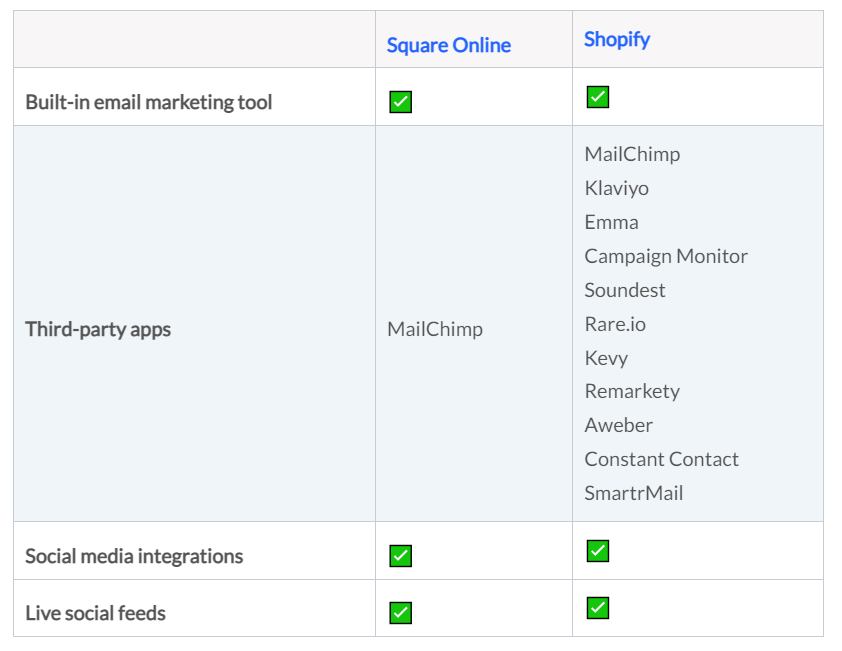
While Square Online users only can use MailChimp, Shopify users have a wider variety of selections. Which can be seen in the image above.
ERP – CRM
Both Shopify and Square provide integration with popular ERP tools like NetSuite, Brightpearl, and Microsoft Dynamics. These tools can help businesses manage their inventory, orders, and fulfillment processes, as well as track important metrics like sales and revenue. However, Shopify’s ecosystem of ERP integrations is generally larger and more diverse and includes tools like QuickBooks, Xero, and SAP Business One.
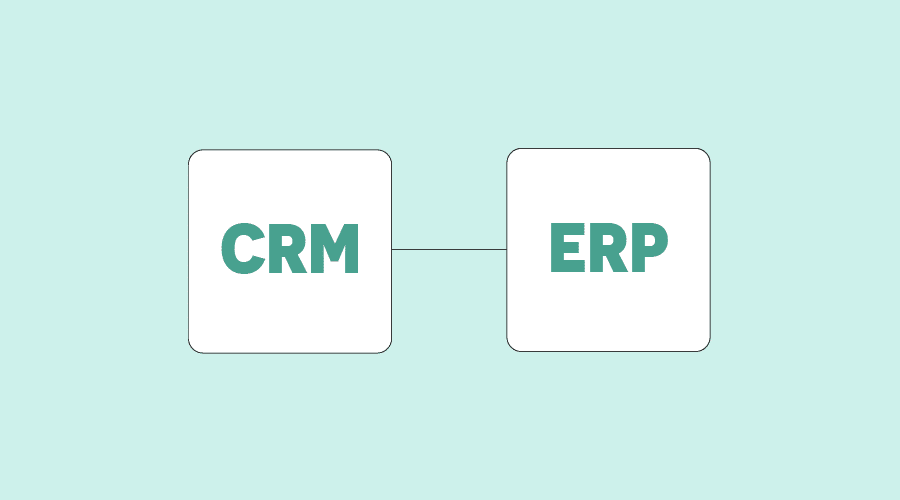
Considering CRM, both Shopify and Square Online provide built-in CRM features that allow businesses to manage their customer relationships and track important customer data like contact information, order history, and preferences. However, Shopify’s CRM features are generally more advanced and customizable and include tools like customer segmentation, email marketing, and abandoned cart recovery. Square’s CRM features are simpler and more limited, and may not be as well-suited to businesses with more advanced CRM needs.
Support
Shopify Support
Shopify excels in terms of providing excellent customer service.
No matter the subscription package you choose, you have access to the reportedly excellent 24/7 customer assistance! They are recognized for responding quickly and offering helpful and doable solutions.
Shopify offers a range of options for communication channels such as email, live web chat, and telephone support.

Additionally, Shopify’s self-help knowledge library includes a wealth of comprehensive materials. Therefore, there’s a strong possibility you’ll be able to resolve your issues without getting in touch with Shopify’s support staff.
Even a very active community forum is available. This is a fantastic location to network with other business owners, web designers, and Shopify users. It’s also a fantastic place to discover the answers to your most pressing queries.
Square Support
Square has invested a lot of time and money into improving its customer service over the past several years, despite the fact that it still falls short of the flawless standard set by Shopify.
Square online, meanwhile, doesn’t offer round-the-clock phone assistance as Shopify does. In order to speak to anyone on their customer service line, you must first acquire a code, which is a hassle.
However, Square has fantastic self-service resources, so much like Shopify, there’s a strong chance you’ll solve your issue right away by reading these articles. You probably won’t need to get in touch with Square’s customer care staff unless you have a sophisticated or account-specific issue.
Pricing
Shopify Pricing
Shopify offers multiple pricing plans ranging from $29/month to $299/month, with additional fees for credit card processing through third-party payment gateways.
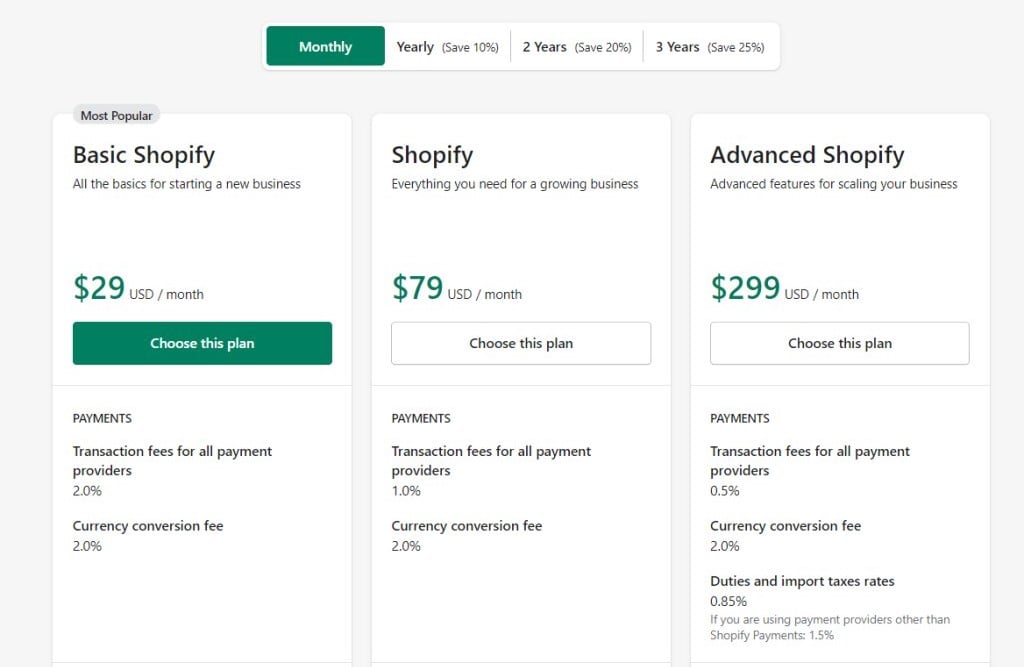
Square Pricing
Square’s pricing is more complex than Shopify’s, as it offers multiple products and services with different pricing structures. For its online store feature, Square Online offers a free plan with basic features like unlimited products and online payments but charges 2.9% + 30¢/transaction. It also offers a $12/month plan with reduced transaction fees and additional features like shipping and discounts.
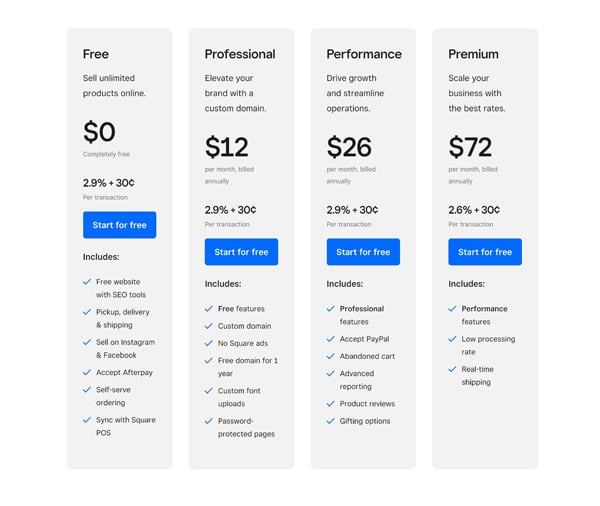
Which Is Better For Your Business?
Choosing Shopify when
- Mindful Branding: Suitable for sellers focused on brand identity and specific design goals.
- Established Businesses: Ideal for eCommerce businesses with a substantial or complex product inventory.
- Long-Term Goals: Great for aspiring sellers with extensive and long-term business ambitions.
- Multi-Channel Presence: Suitable for web-based stores needing multi-channel and online marketing capabilities.
- Payment Flexibility: Beneficial for merchants requiring a wide range of payment gateways and lower processing fees.
Why choose Shopify
We summarize the reasons why businesses choose Shopify rather than Square below:
Start selling with no surprises
With Shopify, you can start selling with full clarity and without any unexpected costs. When comparing pricing between Shopify and Square, you may notice that Square offers free plans; however, businesses may discover that features such as staff permissions and custom domains are only accessible through annual paid plans or monthly add-ons. In contrast, Shopify’s pricing structure is transparent and covers all the necessary tools to operate your business both online and in-store, while allowing you to upgrade, downgrade, or cancel your plan at any time.
Easy to scale
Although Square’s platform is user-friendly, its basic features may not be sufficient for a growing business. On the other hand, Shopify is specifically designed to offer a seamless balance between ease of use and advanced functionality for inventory, payments, orders, and other features.
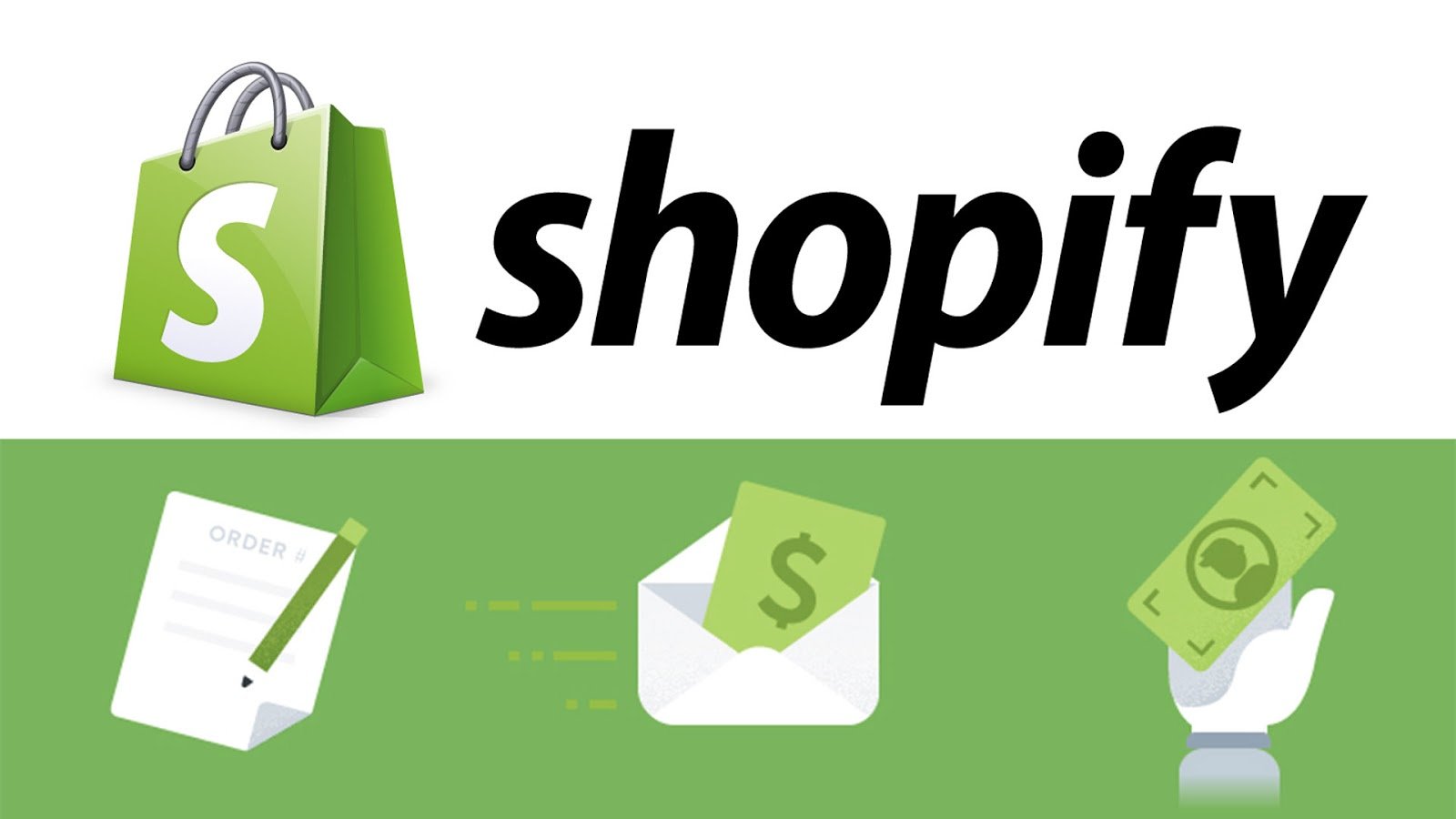
This means that you can begin selling effortlessly and have peace of mind knowing that Shopify’s solution can support your business’s growth, from expanding to new retail locations to entering new international markets.
Have powerful eCommerce features
With the right eCommerce capabilities, your website may become a potent tool for expanding your entire company, both offline and online. Using Shopify’s features, you can do more than just offer local pickup and synchronize your inventory with Square. Shopify can assist you with your growth objectives, no matter what they are, whether you want to start selling wholesale, test out overseas markets, or increase online traffic to your brick-and-mortar businesses.
Sell products everywhere
You may sell with Square online, in-person, and on Facebook, Instagram, and Pinterest. You are covered for all of the aforementioned sales channels as well as over ten more on Shopify, including Groupon, TikTok, and Google Shopping. In addition to making it simple to investigate new possibilities, Shopify’s management of everything makes it possible to sync inventory, combine online orders, and collect data from new customers.
Get 24/7 support
Having reliable support is essential for any retail business, from late-night inventory counts to your weekend rush. On Shopify, a live person is always available to talk to. Due to Square’s limited service hours, if you simply need information, you must use chatbots or help documents.
Choosing Square when
- Small Businesses: Suitable for small and local businesses aiming to establish an online presence.
- Retail and Restaurants: Ideal for small businesses in the retail and restaurant industries.
- Integrated Sales: Beneficial for merchants aiming to sync online and in-person sales via Square’s point-of-sale system.
- Efficiency and Speed: Great for sellers needing a quick and hassle-free setup of an online store.
- Budget-Friendly: Perfect for budget-conscious sellers seeking a cost-effective solution for launching their business.
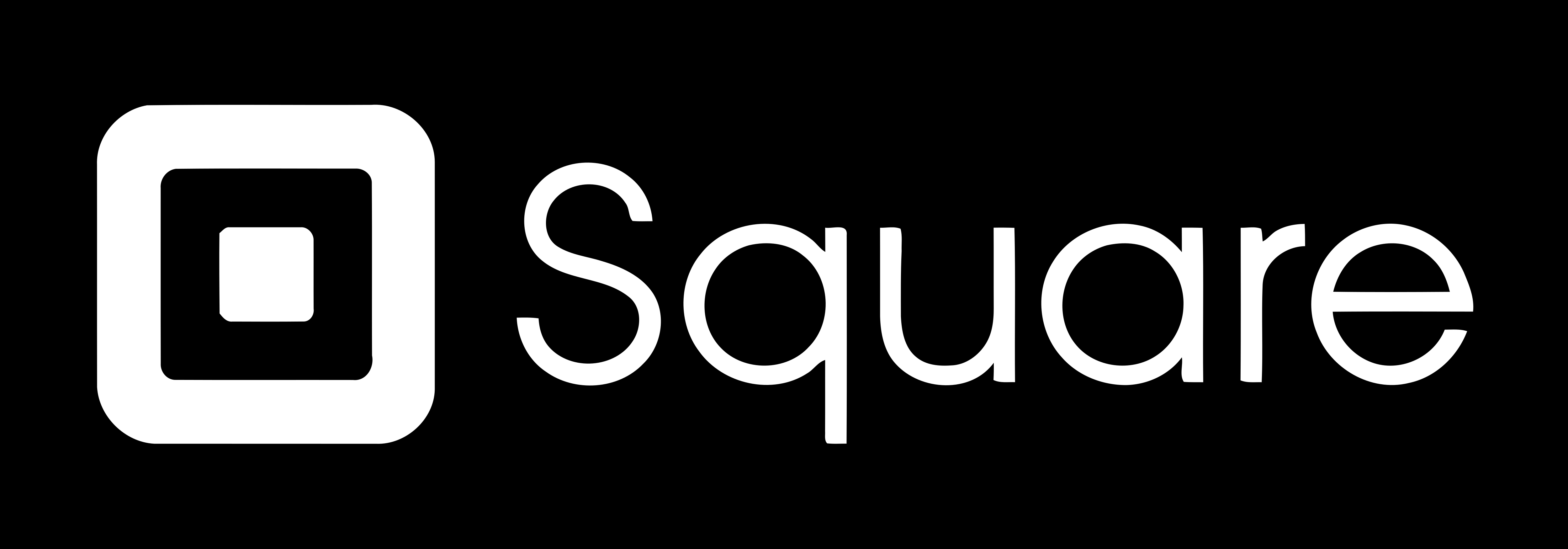
We summarize the reasons why businesses choose Square rather than Shopify below:
- Lower transaction fees: Square online offers a flat-rate fee of 2.6% + 10 cents per transaction for its free plan, while Shopify charges a transaction fee of 2.9% + 30 cents per transaction for its basic plan. For businesses that process a large volume of transactions, this could result in significant savings.
- Easy integration with Square POS: If a business is already using Square’s point-of-sale system for in-person transactions, it might be easier and more convenient to integrate their online sales with the same system.
- Free plan available: Square online offers a free plan that includes basic features for small businesses, while Shopify’s cheapest plan costs $29 per month. This can be an attractive option for budget-conscious entrepreneurs.
- Simplicity and ease of use: Square’s platform is straightforward and easy to use, making it a popular choice for small businesses that don’t need advanced features or customization options.
- Flexible hardware options: Square offers a range of hardware options, including card readers, terminals, and POS systems, which can be customized to meet the specific needs of different businesses.
In conclusion,
Both Shopify and Square are powerful eCommerce platforms that offer unique features and benefits. While Square might be a better option for small businesses with a limited budget and simple needs, Shopify’s comprehensive functionality, flexibility, and scalability make it a top choice for ambitious and growing businesses. When choosing Shopify vs Square online, it’s crucial to consider your business requirements, budget, and growth potential. By comparing features such as ease of use, website design, payment options, inventory management, SEO, blogging, and pricing, you can make an informed decision and select the best platform for your online business.
Ultimately, the success of your online business will depend on many factors, including the quality of your products, your marketing strategy, and your customer service. By leveraging the power of eCommerce platforms like Shopify and Square online, you can streamline your operations, improve your customer experience, and grow your business to new heights.
If choosing one between these two eCommerce platforms leaves you in real confusion, Magenest is more than happy to assist. We are a team of website development experts that not only can help you with creating and maintaining, but also with analyzing, optimizing your website, and so much more. You can first check out our Shopify development services by clicking on the below button.











